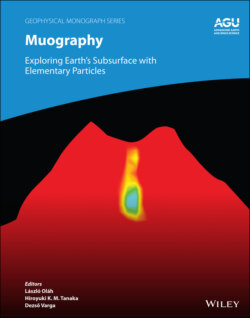Читать книгу Muography - Группа авторов - Страница 11
Preface
ОглавлениеBeing able to visualize Earth's subsurface at a resolution of a few meters has various uses, such as monitoring material movements in geological structures and hydrologic systems, as well as improving our understanding of geophysical phenomena. Muography is a passive and non‐destructive remote sensing technique that has the potential to achieve sufficient spatial resolutions for observing regions of the Earth that are nearly or totally inaccessible. This imaging technique utilizes muons, which originate from naturally occurring radiation created by the interactions of primary cosmic rays with atmospheric nuclei. These highly penetrating, elementary charged particles allow the visualization of the internal structure of human‐made objects and solid geological structures similar to X‐ray radiography in human bodies.
The principle of muography was demonstrated as long ago as the 1950s, but it is only in the past decade that muographic observation instruments have been adapted to operate in varying environmental conditions with sufficient performance and cost‐effectiveness to make muography a practical imaging technique in geosciences. This technique offers new possibilities to volcanology, geophysical exploration, civil engineering, and environmental applications by utilizing environmentally friendly technologies for the reliable, precise, and directionally sensitive measurement of muons.
Many of the technological breakthroughs in muography for geosciences have applications for contemporary society. A global network of scientists and engineers – the International Virtual Muography Institute, of which we are all a part – facilitates information sharing and provides education and support for the community. A recent result of this global collaboration is the Multi‐Aspect Geo‐Muographic Array (MAGMA) experiment, which is under development by various partners from the Americas, Asia, and Europe. MAGMA includes a Global Volcano Muography Network with observatories at Sakurajima (Japan) and Etna (Italy). MAGMA is also developing the Tokyo‐bay Seafloor Hyper KiloMetric Submarine Deep Detector (TS‐HKMSDD), which will explore the local natural gas field and serve as a tide imaging, monitoring, and warning system. The counterpart of TS‐HKMSDD has been designed for installation in the Boulby mine in northern England. Further joint muography research initiatives are operating at La Soufrière, Puy de Dôme, and Vesuvius volcanoes, as well as in the Egyptian pyramids and the Low Noise Underground Laboratory (LSBB).
The objective of this monograph is to present a broad picture of the progress, prospects, and limitations of muography in geophysical research and exploration, volcanology, and environmental applications. The book opens with an overview of the principles, pros, and cons of muography, as well as highlighting pioneering works (Chapter 1). Part I reviews different muographic image processing approaches, including how to reveal three‐dimensional density structures of volcano edifices (Chapters 2 and 3), and machine learning of muographic image data for volcano eruption forecasting (Chapter 4). Part II focuses on volcanic phenomena, with muography used as a standalone option as well as in conjunction with standard geophysical observation techniques. Different contributions look at muographic imaging of the dynamics of hydrothermal activities (Chapter 5), shallow magma supply systems (Chapter 6), tectonic evolution of vent structures (Chapter 7), and magmatic plug formation and explosion (Chapters 8 and 9). Part III explores the potential of muography to be applied to other geophysical and environmental applications, such as water management, resilient cities, climate action, and affordable or sustainable energy. Experts with practical experience describe how to apply muography to the exploration of underground water and karstic cave systems (Chapters 10 and 11), detection of underground cavities (Chapters 11 and 12), monitoring of glaciers and carbon capture storage sites (Chapters 13 and 14), as well as for applications in mineral exploration, mine geology, and geotechnical and mining engineering (Chapters 15 and 16). Part IV turns to recent technological developments for next‐generation muography, including compact muographic observation systems that are based on scintillators (Chapter 17), gaseous detectors (Chapters 18, 19, and 20), and nuclear emulsions (Chapter 21), which will provide optimal imaging resolution, operational reliability, and efficiency in the challenging natural environment of field operations.
This work aims to extend and deepen the knowledge of geophysicists, geologists, mining and mineral exploration professionals, volcanologists, and engineers about the applicability of muography. It will help them to assess how this technique can complement conventional geophysical observations and explore which scientific questions can be addressed by muography experiments. This monograph can also serve as an introduction to muography for those new to using this technique and aid the cooperation between developers and users, which is a prerequisite to making muography a standardized technique. This cooperation will be critical for using muography in a broad range of applications.
The editors would like to thank all the contributing authors, many of them leaders in the field, for their valuable chapters. Guest editors Constantin Athanassas, Tadahiro Kin, David Mahon, and several anonymous reviewers were greatly appreciated for their constructive reviews that improved the quality of the chapters. We also thank the American Geophysical Union and John Wiley & Sons, Inc. for providing the opportunity and continuous support for the publication of this book.
László Oláh The University of Tokyo, Japan and International Virtual Muography Institute, Global
Hiroyuki K. M. Tanaka The University of Tokyo, Japan and International Virtual Muography Institute, Global
Dezső Varga Wigner Research Centre for Physics, Hungary and International Virtual Muography Institute, Global
